Understanding Grub Damage and Lawn Management Strategies
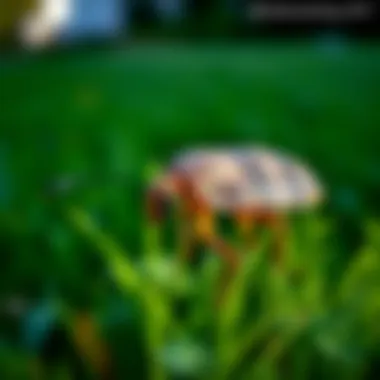
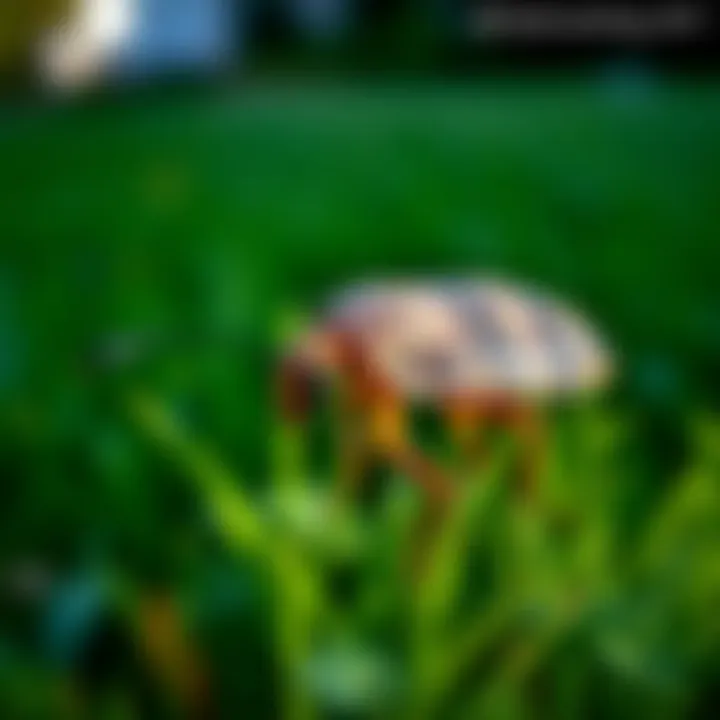
Intro
Grubs, the larvae of various beetles, might seem harmless at first glance, but when they decide to take up residence in your lawn, they can cause quite the ruckus. These little critters feed on the roots of grass, leading to unsightly patches and ultimately, a lawn that can look more like a battlefield than a flourishing green space. For homeowners and lawn care enthusiasts alike, understanding grub damage is essential not just for the sake of aesthetics, but for the overall health of your lawn. After all, a lush lawn is not just a joy to behold; it’s also an indicator of a healthy ecosystem.
In this article, we will dig deep into the world of grubs, discussing how to spot them, what causes them to invade, and the best ways to keep them at bay. By learning about the lifecycle of these pests, we can better equip ourselves to tackle any problems they may present. Whether you are a seasoned gardener or a newbie just trying to keep your yard looking sharp, this guide will provide a wealth of knowledge for managing grub damage effectively.
Preamble to Grub Damage
Grub damage is more than just an unsightly nuisance on your lawn, it signals underlying issues that may need addressing. Understanding the behavior and impact of grubs can help homeowners and horticulturalists achieve a vibrant and healthy lawn. Having this insight is crucial for devising appropriate management strategies that can mitigate damage and promote grass health.
Defining Grub Damage
Grub damage refers to the harm caused by the larval stage of beetles to grass roots, leading to patches of dead or dying turf. Grubs primarily feed on the roots of plants, which can result in wilting, yellowing, and ultimately the death of grass. The most commonly known grubs are those of the Japanese beetle, European chafer, and June beetle. In severe infestations, lawns may feel spongy underfoot, revealing a concerning level of root damage.
Grub damage isn't just a seasonal issue, either. Infestations can escalate quickly if the conditions are right, leading to large areas of lawn that appear lifeless. Recognizing the signs early on can help you adapt and protect your investments in landscaping.
Importance of Understanding Grubs
Gaining insight into grub behavior and lifecycle can lead to effective management and prevention strategies. Understanding why these pests thrive in your region provides a roadmap for proactive care. For instance, if you know your area's beetle populations peak during a certain season, you can make informed decisions about treatments and preventive measures.
Moreover, awareness of how environmental factors, such as soil moisture and temperature, influence grub activity aids in planning your lawn management schedule. It can help in applying cultural practices and selecting grass varieties that show resilience against these pests, thus promoting a healthier lawn overall.
Knowledge is power. Understanding grub behavior allows you to take preventative action rather than merely responding to infestations.
In summary, grasping the significance of grub damage and actively monitoring your lawn can yield benefits that go beyond aesthetics. Healthy grass contributes to a vibrant ecosystem, and being proactive in managing grub populations can preserve not just your yard, but also a thriving local environment.
Identifying Grub Damage
Identifying grub damage is crucial for any lawn enthusiast or farmer who aims to maintain a lush, thriving green space. Grubs, the immature stage of beetles, can wreak havoc on grass quality when left unchecked. Recognizing the early signs of infestation can make the difference between a swift recovery and a long, uphill battle against a decaying lawn. Each identification method not only enables you to grasp the extent of the problem but also paves the way for implementing effective management solutions. Without proper identification, even the most sophisticated lawn care practices may falter, leading to significant loss of investment in time and resources.
Visual Signs of Damage
When it comes to spotting grub damage, one of the first indicators can be found simply by looking around. Lawns suffering from grub activity often exhibit several specific visual signs, and being able to recognize these can save you a world of trouble.
- Brown Patches: Grass may start to yellow or brown in irregular patches, signaling that the roots are compromised due to the grubs consuming foundational elements.
- Sod that Lifts Easily: Grub-infested areas will often have sod that peels away easily, akin to a loose carpet. This is due to the roots being eaten away, causing instability.
- Presence of Beetles: Look for adult beetles around your lawn, particularly during certain months - they typically emerge in warmer seasons. Spotting them can be a red flag indicating their offspring may be causing problems below the surface.
These visual cues serve as an immediate clue to whether or not you should investigate further. Remember, acting swiftly often yields the best results in mitigating the damage.
Assessing Grass Health
An in-depth assessment of your lawn’s grass health can provide valuable insights into the extent of grub damage. This involves more than a mere glance; it demands a systematic evaluation of the grass and its overall condition.
- Grass Color: Observe if the grass is struggling to maintain a vibrant green color. Healthier grass tends to have more resilience to drought and pests, while faded and brittle blades may hint at underlying issues.
- Soil Moisture Levels: Healthy grass should thrive in soil that's consistently moist. If the soil feels dry despite regular watering, you may be experiencing disruptions caused by grubs.
- Resistance to Stress: Tug gently on the grass blades. If they come out too easily or feel weak, this is another sign of potential grub damage.
- Biodiversity of Grasses: Have you noticed particular grasses in your lawn that are faring better than others? For instance, if Kentucky bluegrass is browning severely while fescue remains healthy, it could indicate that the former is more susceptible to grub damage.
By regularly engaging in grass health assessments, you stand a better chance of mitigating grub damage, allowing your lawn the opportunity to thrive.
Soil Examination Techniques
While visual signs and grass health assessments provide preliminary information, an in-depth soil examination is often the final frontier in identifying grub presence. Here are some effective methods:
- Soil Digging: Using a spade or trowel, dig a small section of soil when you suspect infestation. Look specifically for the white, C-shaped grubs that will be nestled in the soil. It's best to sift through about one square foot of soil to get an accurate count.
- Soil Testing Kits: Many gardening shops offer soil testing kits that can offer insight into other potential health issues in your lawn that might be weakening it against grubs, such as pH level or nutrient deficiencies.
- Observation of Soil Texture: Pay attention to the texture and composition of your soil. Well-aerated soil is less friendly to succesful grubs while compacted or wet soil may create an ideal habitat.
- Researching Local Grub Activity: Your local agricultural extension office may provide insight on typical grub populations in your area during specific times of year, helping to contextualize your findings.
By employing these soil examination techniques, you can gain a comprehensive understanding of the grub population within your lawn and better prepare for effective management strategies.
Identifying grub damage early can save homeowners a considerable sum in potential restoration costs.
In summary, by sharpening your skills in identifying grub damage, you position yourself not just as a caretaker of your lawn but as a proactive guardian against potential infestations. A vigilant approach ensures that your green spaces thrive, providing an inviting sanctuary for both humans and wildlife alike.
Lifecycle of Grubs
Understanding the lifecycle of grubs is pivotal to grasping their impact on lawns and how to effectively manage them. Knowing the various stages of these pests can significantly influence your management strategies and preventative measures. Each phase in a grub’s life lends unique insights into their behavior and geographical spread, which, in turn, helps in customizing approaches for different lawns.
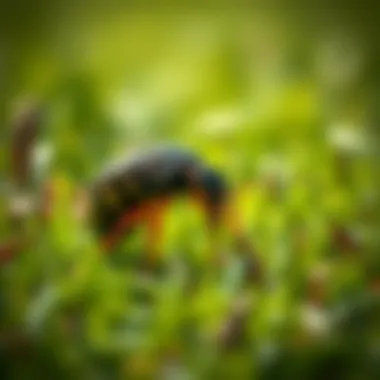
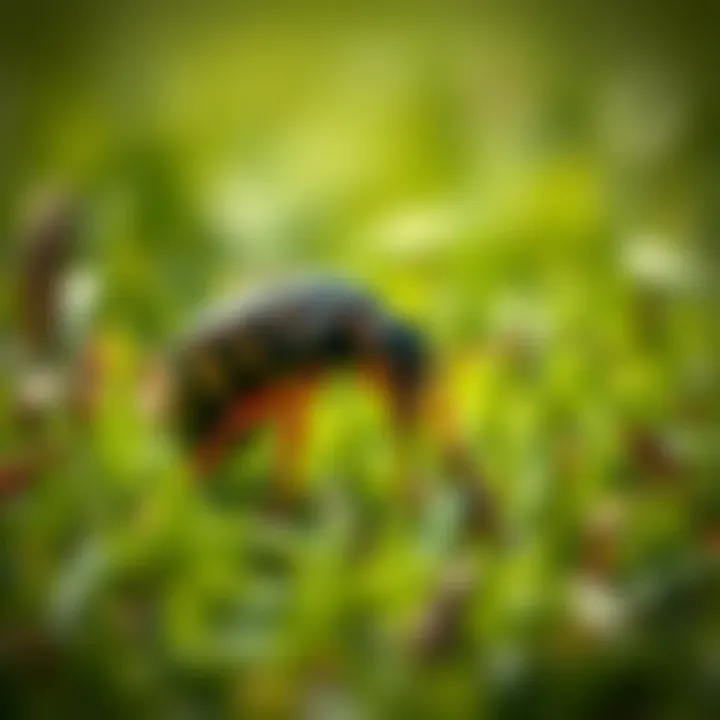
Egg Stage Overview
The lifecycle of grubs begins with the egg stage. Adult beetles typically lay eggs during late spring to early summer, preferring moist soil for optimal survival. Each female can deposit anywhere from 30 to 50 eggs at a time, often in clusters, right at the grass roots.
- Egg Characteristics: The eggs are small, usually white or light tan in color, and tend to be oval-shaped. They are not easily noticeable, often lying hidden beneath the soil surface.
- Ideal Conditions: Remember, grubs thrive in areas with sufficient moisture; thus, watering your lawn excessively can inadvertently create a hospitable environment for them.
Once laid, these eggs need a warm, moist environment to hatch, which explains why regions with hot summers and moderate rains are often prone to grub infestations. The understanding of this stage is not just academic; it’s a crucial step in timing your preventive measures.
*"By recognizing the importance of the egg stage, you can implement measures to discourage adult beetles from laying eggs in your lawn."
Larval Stage Characteristics
Following the egg stage, grubs hatch into larvae, which is the most damaging phase for your lawn. The larvae are usually white, C-shaped grubs, comprising several species such as the Japanese Beetle and European Masked Chafers. Each species has its own quirks, but there are common characteristics across the board.
- Damage Symptoms: Grubs feed on the roots of grass, causing sections to wilt and eventually die. The grass may pull up easily when tugged, indicating root damage. This stage can last several weeks, allowing the pests to wreak havoc if not addressed promptly.
- Feeding Timeframe: In general, the larvae are most active in late summer and early fall. This is when lawn damages tend to become critical, making inspections and timely interventions vital during this time.
As these larvae grow, they undergo multiple molts, expanding in size. Understanding their feeding habits and peak activity periods can aid farmers and lawn care enthusiasts in timing their interventions effectively.
Transformation to Adult Beetles
As temperatures drop in the fall, grubs begin the process of overwintering in soil, eventually transforming into adult beetles by late spring. This transformation can provide some interesting dynamics for lawn care practitioners, as the adult beetles will be responsible for the next generation of grubs.
- Life Cycle Completion: The change from larvae to adult beetles can take several months. Once they emerge, the beetles will seek out suitable locations to feed and mate. Knowing this transition can help in planning applications of pesticides before beetles emerge, thereby curbing future generations of grubs.
- Periodic Checkpoints: Adult beetles tend to be very active for a couple of months during summer, laying the groundwork for the next cycle of damage potential. This is a crucial period for monitoring your lawn’s health.
Recognizing the full lifecycle of grubs therefore becomes invaluable not only in mitigating existing damage but also in preventing future infestations from taking root.
Causes of Grub Infestation
Understanding the causes of grub infestation is crucial for anyone interested in maintaining a healthy lawn. Recognizing these factors allows homeowners and lawn care professionals to take effective steps to mitigate the risks associated with grub damage. Grubs thrive under specific conditions, and awareness of these can significantly influence management strategies and lawn health.
Environmental Factors
The environment plays a pivotal role in grub infestation. Weather patterns, particularly warmth and moisture, create ideal breeding conditions for grubs. For instance, a particularly wet spring or a warm summer stimulates both adult beetle activity and egg-laying. Homeowners should watch for these patterns, as they can indicate potential grub activity. A dry spring, conversely, may hinder grub life cycles. Regular monitoring of weather conditions ensures timely interventions.
- Temperature: Warmer temperatures can elevate grub populations. In the range of 70 to 90 degrees Fahrenheit, conditions are perfect for grubs to thrive.
- Moisture Levels: Adequate soil moisture not only helps grass health but also encourages grubs. Waterlogged soils can make lawns more inviting to these pests.
"Your lawn's health is a reflection of the environment around it; be attentive to changes, and you can steer clear of grub troubles."
Host Grass Species Vulnerability
Not all grass types are equally susceptible to grubs. Some species, like Kentucky Bluegrass, tend to resist infestation better than others. Familiarizing oneself with the particular grass varieties will help in choosing the right type for your lawn, especially in areas known for grub issues. Knowing your grass's strengths and weaknesses can inform preventative measures. Here are some points to consider:
- Resilient Grass Types: Bermudagrass and Tall Fescue tend to stand up better against grub damage, making them preferable choices in vulnerable areas.
- Grass Length: Keeping the lawn at the proper height is important. Grass that is too short becomes more susceptible to grub damage, as it struggles to recover from feeding.
Soil Conditions
Soil health is another essential piece of the puzzle when it comes to grub infestations. The quality of the soil directly influences the ability of grubs to thrive. Compacted soil, for example, may retain moisture, thus providing a perfect environment for grubs to develop. Soil that lacks adequate nutrients or fails to drain well is more likely to see increased grub populations. Some factors to monitor include:
- Compaction: Loose soil promotes healthy grass while compacted soil invites pests. Aeration should be performed regularly to improve soil structure.
- Nutrient Deficiency: Keeping soil nutrient-rich supports strong grass that can better withstand grub attacks. Adding organic matter can enhance soil quality.
Understanding these causes of grub infestation can create a pathway toward a more robust lawn management plan, reducing the likelihood of a major pest problem during peak seasons.
Management Strategies for Grub Damage
Understanding how to manage grub damage is crucial for preserving the health and appearance of your lawn. It involves taking a multi-faceted approach that encompasses various strategies tailored to address the unique challenges posed by these pests. Homeowners and lawn care professionals alike can benefit from effective management to ensure lawns remain lush and appealing.
Cultural practices, chemical control, and biological methods all present valuable options for combatting grubs. Each strategy has its strengths and considerations, which can either complement one another or serve as stand-alone solutions. Choosing the right combination can significantly impact the success of lawn management efforts.
Cultural Practices
Engaging in cultural practices involves utilizing methods that promote the overall health of the lawn. By creating an environment less favorable to grubs, these practices can serve as the first line of defense. Here are some effective cultural practices to consider:
- Proper Watering Techniques: Overwatering or underwatering can weaken grass, making it more susceptible to grub damage. A consistent watering schedule that allows for deep penetration encourages strong root systems.
- Mowing Height: Keeping grass at a suitable height can help it withstand pests. Taller grass can shade the soil, making it less inviting for egg-laying beetles.
- Soil Aeration: Aerating the soil allows for better nutrient and water absorption. Aerated lawns also deter grubs, as well-aerated soil is more difficult for them to inhabit.
- Dethatching: Thick layers of thatch can provide a cozy home for grubs. Regularly dethatching the lawn helps keep the soil healthy and minimizes grub habitats.
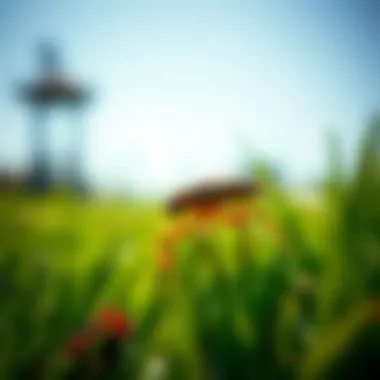
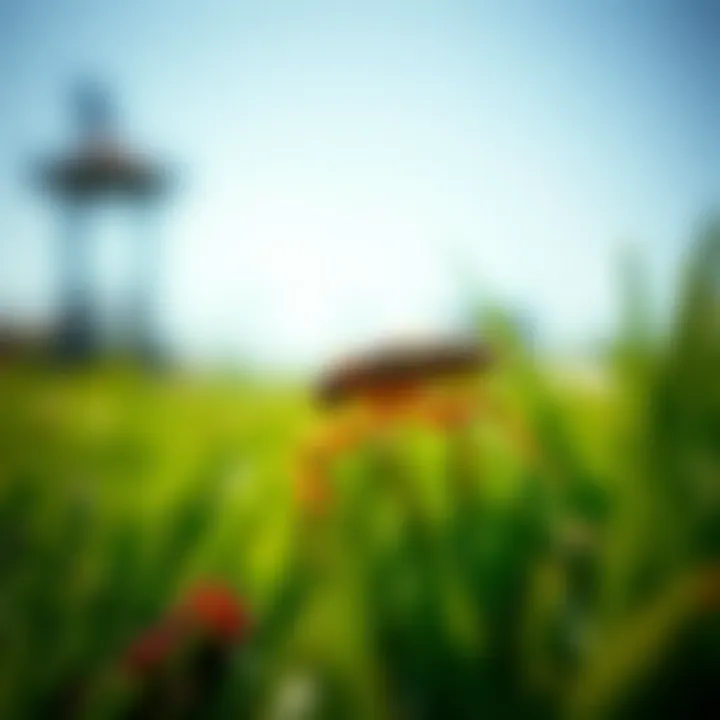
These cultural practices reduce the reliance on pesticides, thus promoting a more sustainable lawn care regimen.
Chemical Control Options
For those battling significant infestations, chemical treatments may be necessary. Selecting the right chemical control is crucial for effective grub management. Here are a few chemical options homeowners might consider:
- Granular Insecticides: Products such as Merit 0.5G contain active ingredients that target grubs effectively. When used according to the label, they can provide long-lasting protection.
- Liquid Insecticides: These provide quick knockdown of active grubs in the soil. For instance, SpeedZone Lawn Weed Killer can be effective when applied during appropriate life stages of the grubs.
- Timing is Key: Application timing is paramount. It’s best to apply these products during the grub's active feeding phases—usually late summer to early fall and sometimes in spring, depending on the species.
While chemical options can offer immediate results, it’s pivotal to follow local regulations to protect beneficial insects and the surrounding environment.
Biological Control Methods
Adopting biological control methods can be an effective alternative or complement to chemical treatments, often resulting in a permanent solution without significant environmental impact. Here are a few biological approaches:
- Beneficial Nematodes: These microscopic worms can be applied to the soil and attack grubs at several life stages. They invite fewer ecological concerns since they primarily target the pests without harming other organisms.
- Fungi-Based Products: Some products utilize naturally occurring fungi, such as Beauveria bassiana, which infects and kills grubs when applied effectively to the lawn.
- Encouraging Natural Predators: Creating an ecosystem that attracts birds and other natural predators can assist in managing grub populations. For instance, certain birds feed on grubs, thus helping to keep their numbers in check.
Incorporating these biological methods aligns with sustainable landscaping practices, hence boosting long-term health for lawns.
By employing a combination of these management strategies, homeowners and lawn care enthusiasts can tackle the challenges posed by grubs while fostering an environment that promotes a vibrant and resilient lawn.
Preventative Measures
Preventative measures are the first line of defense when it comes to managing grub damage in lawns. Focusing on prevention not only saves time and resources but also ensures a healthier yard in the long run. In this section, we navigate through practical strategies that can significantly reduce the likelihood of grub infestations, ultimately preserving the beauty and vitality of your lawn.
Regular Lawn Maintenance
Maintaining a regular lawn care routine is essential for yard health. One of the simplest things that can go a long way is to mow your lawn at the appropriate height. Cutting the grass too short stresses it, making it more vulnerable to pests like grubs. Moreover, keeping a consistent watering schedule can promote deeper root growth, leading to stronger grass that can withstand grub attacks.
- Aeration: Aerating your lawn allows air, water, and nutrients to penetrate deep into the soil, strengthening grass roots. This practice not only boosts grass health but also elevates the soil quality, creating an inhospitable environment for grubs.
- Fertilization: Using organic fertilizers can also enhance grass vigor. A lush lawn with robust growth can often outcompete pests for resources, making it less susceptible to grub damage.
- Weed Control: Finally, keeping weeds in check is critical. Weeds can harbor pests and complicate the turf's ability to thrive. Regularly pulling them can help your lawn remain strong and healthy.
Use of Grub-Resistant Grass Varieties
Choosing the right grass variety is another effective preventive measure. Some grass species are inherently more resistant to grubs and other pests, reducing the risk of significant damage. Exploring varieties like Tall Fescue or Bermudagrass can provide your lawn with a critical edge against infestation.
- Turf Type Tall Fescue: This variety is tolerant to various temperatures and has a deep root system, making it resilient against pests.
- Bermudagrass: Particularly known for its hardiness, it can thrive under both drought and heavy foot traffic conditions, leaving less room for grubs to establish.
Selecting and planting these varieties can ultimately reduce your need for chemical controls, ensuring your lawn is both healthy and environmentally friendly.
Soil Health Improvement Techniques
Soil health is pivotal in creating a resilient lawn. A rich and balanced soil ecosystem fosters strong grass while deterring pest populations, including grubs. Thus, implementing soil improvement techniques is paramount.
- Soil Testing: Before you initiate any improvement techniques, conducting a soil test is essential. Being aware of your soil’s pH level and nutrient content can offer insights into necessary amendments.
- Adding Compost: Incorporating compost into your soil enhances nutrient content and microorganism activity. A diverse microbial community can fight back against pest outbreaks, providing a natural defense.
- Mulching: Applying organic mulch can help maintain soil moisture levels while reducing weed growth. This creates a more favorable environment for your grass to flourish.
Regular attention to soil health and proper landscaping practices can yield significant benefits in pest management. The stronger and healthier the turf, the less appealing it becomes to grubs.
These preventative measures create a comprehensive approach to managing grub damage in lawns. By investing time and effort into regular lawn maintenance, selecting resistant grass varieties, and improving soil health, homeowners can protect their lawns from the grip of grubs while also promoting sustainable landscaping practices for the future.
The Role of Climate Change
Climate change doesn't just affect our planet in broad strokes, like rising sea levels or melting glaciers. It trickles down to affect the intricacies of our daily lives, including the health of our lawns. Understanding the interaction between climate change and grub populations is essential in effective lawn management. As warmer temperatures and erratic weather patterns become the new norm, these factors influence the occurrence and lifecycle of grubs in notable ways.
Effects on Grub Populations
With the temperature creeping up, grubs tend to flourish in many regions that previously struggled with their prevalence. Higher warmth not only speeds up the lifecycle of grubs but also expands their range into areas that weren't hospitable before. Here are some key points to understand this phenomenon:
- Extended Lifecycle: Warmer winters mean grubs are less likely to die off during the cold months. Their survival rates increase, leading to higher populations come spring.
- Enhanced Feeding Opportunities: Sustained heat provides a longer feeding period for larvae, resulting in more significant damage not just to lawns but to other plants they may infest.
- Species Adaptability: Some grub species, like the Japanese beetle larva, are adjusting to new climate conditions, which can lead to unexpected outbreaks in areas where they were rare.
- Change in Natural Predators: Climate shifts can also impact the predators that naturally keep grub numbers in check, thereby allowing grub populations to explode.
In effect, homeowners and lawn care professionals must be vigilant, adjusting their strategies to account for these heightened grub challenges.
Changing Lawn Care Practices
As we face the realities of climate change, lawn care practices need to adapt. You can't approach lawn care with a "one-size-fits-all" mindset anymore. Here’s how changing weather patterns are prompting shifts in how we tend to our grassy green spaces:
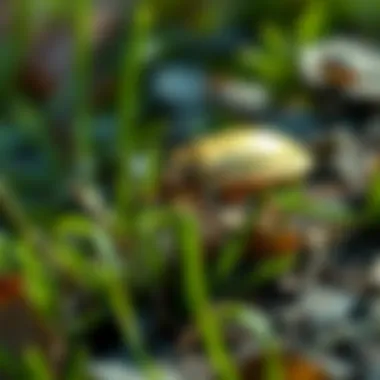
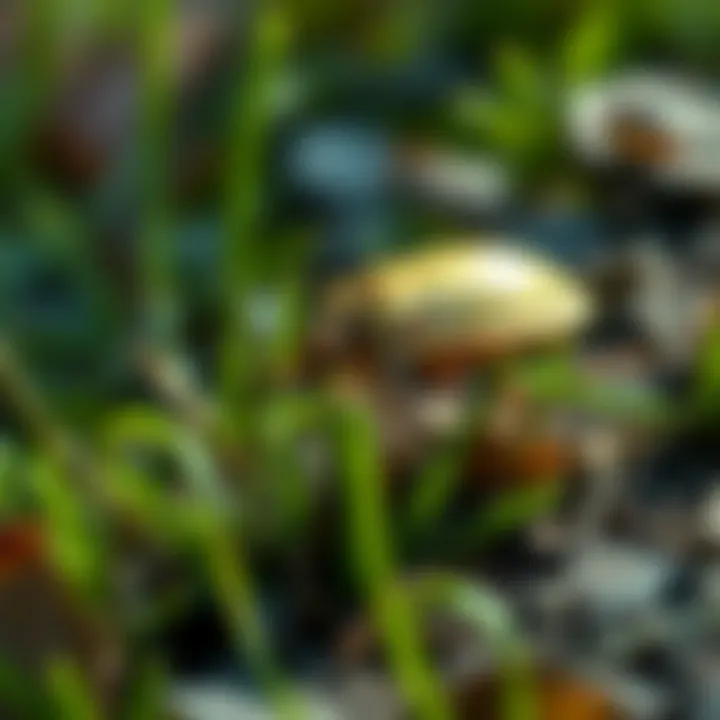
- Soil Management: Improved soil health is a pivotal way to combat the negative impacts of grubs. Regular aeration and organic matter amendments not only enhance plant resilience but also enhance your soil's biodiversity, allowing beneficial microorganisms and predatory insects to thrive.
- Watering Practices: With unpredictable rainfall, knowing when and how much to water becomes crucial. Establishing a watering schedule that prioritizes moisture retention and deep root growth helps grass withstand grub infestations better.
- Use of Technology: Embracing smart lawn care technologies, like moisture sensors and pest diagnostics, can help tailor lawn management strategies based on real-time data, ensuring that resources are used efficiently.
- Emphasis on Biodiversity: By planting a variety of grass types or even native plants, lawns might become less susceptible to pest populations as they create a more complex ecosystem that supports predator species.
"Adaptation is not just a response; it is an essential strategy for thriving in a rapidly changing environment."
By being proactive and forming these adaptive practices, homeowners can offset the effects of climate change, leading to healthier lawns that can withstand grub invasions. In the long run, effective management is all about being resilient and ready to tackle challenges head-on.
Impacts of Grub Damage on Lawn Aesthetics
Understanding the impacts of grub damage on lawn aesthetics is crucial for any homeowner or professional looking to maintain the beauty of their green spaces. Grubs, particularly the larvae of various beetles, can wreak havoc beneath the soil, leading to visible destruction above ground. Recognizing these implications is not just about maintaining an appealing lawn; it is also about addressing the comprehensive health and financial viability of a landscape.
Economic Implications
Grub damage can translate directly into financial loss. When grubs infest a lawn, they typically feed on grass roots, leading to patches where grass wilts and dies, creating bare spots across the yard. This degradation not only affects the flourishing appearance of the lawn but can also lead to increased costs in several areas.
- Replanting Expenses: Homeowners often find themselves in a position where they must reseed or sod to restore their lawns. This process can be both time-consuming and costly.
- Maintenance Costs: A damaged lawn requires more attention, such as increased watering or fertilization to revive the grass. These additional inputs inflate maintenance budgets and ongoing lawn care expenditures.
- Property Value Declines: A lawn that looks neglected can significantly impact property value. Potential buyers may see grub-damaged lawns as a red flag, fearing hidden issues that could require costly repairs, thus lowering market demand.
The financial burden of grub damage can add up quickly, leading to an urgent need for effective management strategies that not just address current issues but also mitigate future risks.
Social Perceptions of Lawn Quality
Lawn aesthetics also plays a key role in how neighbors and community members perceive a property. A well-manicured lawn can project status and pride, while a damaged lawn can stir up negative connotations. The social implications of grub damage are multi-faceted.
- Neighborhood Standards: Many communities have informal standards regarding lawn quality that homeowners feel pressured to uphold. A grub-infested lawn can quickly become the talk of the block, often leading to feelings of shame or embarrassment among homeowners.
- Social Status Reflection: Lawns often serve as a reflection of the homeowners’ care and investment in their property. In communities where lush, green grass is the norm, having visible damage due to grubs might lead to bouts of social anxiety about one’s home maintaining its status among peers.
- Community Engagement: Beautifully maintained lawns often encourage social interactions. Families may host barbecues or gatherings, fostering community spirit. Conversely, a lawn marred by grub damage can lead to isolation, as homeowners may feel less inclined to engage in outdoor activities or invite friends over.
In this way, grub damage extends beyond mere aesthetics; it can reshape social dynamics within neighborhoods. Homeowners are encouraged to consider both the financial implications and the potential degradation of community spirit when managing their landscapes.
"A lawn isn’t just grass; it’s a canvas of social connection and economic value."
Future of Grub Management
The realm of grub management is evolving, spurred by a combination of technological advancements and a deeper understanding of ecological dynamics. This segment aims to shed light on how these factors intertwine to affect the future strategies for managing grub populations effectively. With a growing awareness among gardeners and agricultural professionals alike, the significance of addressing grub issues cannot be understated. It's not merely about eliminating pests; it’s about crafting resilient lawns that thrive amid environmental changes.
Innovative Technologies
In recent years, a slew of innovative technologies have emerged, reshaping how we tackle grub infestations. Precision agriculture tools, for instance, utilize satellite imagery and drone reconnaissance to identify problem areas even before noticeable damage occurs. These high-tech methods allow professionals to apply interventions strategically, preventing the risks associated with widespread pest outbreaks.
Moreover, soil sensors have gained traction. They monitor moisture and nutrient levels in real-time, providing valuable data that can help in formulating a customized lawn care regime that inherently resists pest infestations. Intelligent irrigation systems, working in synergetic harmony with these sensors, ensure that grass maintains optimal health without the overuse of water, thereby fostering a tougher turf that can outconvince potential grub threats.
Another promising avenue is the utilization of biotechnology. This includes the development of eco-friendly pest control solutions that target grubs specifically, without harming beneficial insects in the process. For example, genetically modified organisms (GMOs) or naturally occurring microorganisms are being studied to provide targeted defense mechanisms that can reduce reliance on traditional pesticides.
Research Trends in Pest Management
As researchers delve deeper into the study of grubs, several emerging trends are worthy of noting. One prevalent theme is the shift toward integrated pest management (IPM). IPM emphasizes a holistic view, integrating cultural, biological, and chemical practices to manage pests efficiently and sustainably. The approach encourages the use of multiple strategies, such as crop rotation and intercropping, which can disrupt the lifecycle of grubs.
Furthermore, researchers are exploring the impact of climate change on grub populations. Understanding how temperature changes affect the lifecycle and behavior of grubs is crucial for predicting outbreaks. Studies indicate that warmer temperatures may lead to a longer feeding period for grubs, which intensifies damage in lawns. This insight drives the need for adaptive management strategies that can pivot according to climatic trends.
"Sustainable practices in grub management not only protect our lawns but also maintain the ecological balance necessary for vibrant ecosystems."
Lastly, public perception and awareness of pesticide impacts have catalyzed a move toward organic pest management options. Increasingly, homeowners are gravitating toward sustainable landscaping practices, calling for research into non-toxic alternatives that promote environmental health while combating pest problems effectively.
As these research trends continue to develop, there’s potential for profound changes in how grubs are managed, promising solutions that benefit both the lawn and the larger ecosystem.
Culmination
Grub damage can create considerable challenges for both the appearance and health of lawns. This article highlights critical insights into identifying, managing, and preventing such damage, serving as a valuable resource for lawn care enthusiasts and professionals alike.
Summary of Key Points
Grub damage impacts a lawn's vitality significantly. Understanding the lifecycle of these pests aids in effective identification and management strategies. Key points include:
- Identifying Grub Damage: Awareness of visual signs, assessment of grass health, and soil examination are essential steps for early detection.
- Lifecycle of Grubs: Knowledge of their stages from egg to adult beetle informs timing for intervention.
- Management Strategies: A multifaceted approach comprising cultural, chemical, and biological methods enables effective control.
- Preventative Measures: Regular lawn maintenance, the use of resistant grass varieties, and enhancing soil health can reduce the likelihood of grub infestations.
- Climate Change: It plays a role in the dynamics of grub populations and necessitates adaptation in lawn care practices to keep grubs at bay.
Encouragement for Sustainable Practices
Sustainable practices stand at the forefront of effective grub management. By adopting approaches that prioritize the health of the ecosystem, lawn enthusiasts can maintain beautiful landscapes without compromising environmental integrity. Some suggestions include:
- Utilize organic amendments to improve soil structure and fertility.
- Focus on natural pest deterrents instead of solely relying on chemical pesticides.
- Incorporate crop rotation or mixed planting strategies to disrupt grub lifecycles.
- Educate homeowners on the benefits of maintaining biodiversity in their yards to foster resilience against pest outbreaks.
Implementing these sustainable practices not only fights grub damage but also enhances the broader ecological health of our surroundings.



